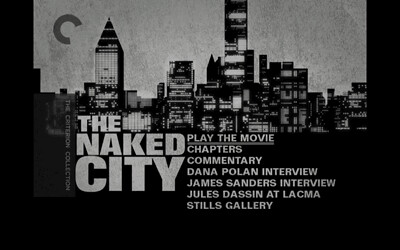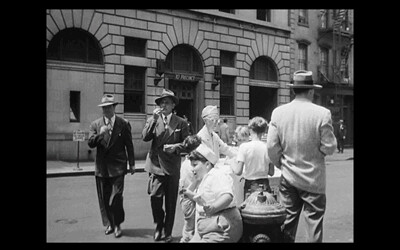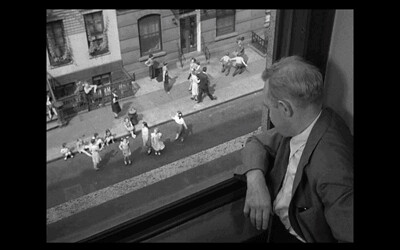"While you're thinkin' up a nice story about what didn't happen, supposin' you tell us what did."
Though the 1948 film version of The Naked City is regularly listed on the classic rosters of film noir, in many ways, I would argue for it being almost an anti-noir, Jules Dassin's clean-up on aisle hardboiled. While notably trading the impressionistic shadows that were a hallmark of the genre with the documentary look of Neorealism (swapping, in effect, the Germans for the Italians), he also extracts the dark cynicism from the crime picture, creating instead a police procedural where the good guys are clearly defined and the bad guys unambiguously punished. Though Dassin still had a few noirish tricks up his sleeve (Night & the City and Rififi were yet to come), he practically invented a whole other animal with The Naked City, eventually spawning the television show of the same name and paving the way for other day-in-the-life cop shows like Dragnet and the contemporary Law & Order franchise, as well as films like Mervyn LeRoy's The FBI Story
The concept seems ridiculously simple now. Shoot on the streets of New York, in real locations, and follow the investigation of one crime from the discovery of the body through to the apprehension of the murderers. The lead officers establish the unshakable paradigm of the seasoned veteran and the well-meaning rookie: the wonderfully nonchalant Det. Lt. Muldoon (Barry Fitzgerald, The Quiet Man) and the do-gooder family man Jimmy Halloran (Don Taylor, The Flying Leathernecks). Though these two men will essentially be our guides through the complicated case, the camera will actually drift from them to follow the cops on the street tailing suspects, the crime labs going over the evidence, and, in a true stroke of genius, the citizens of the city itself.

Even though The Naked City takes place over several days, Dassin and his screenwriters (Albert Maltz and Malvin Wald) framed the story like it was one day, opening the picture as the sun is setting and night life is entering into full swing. Led by a lively narrator (Mark Hellinger, the movie's producer, speaking as himself), the camera visits people on the night shift and in swank society parties, eavesdropping on the thoughts that drive their evening out or that keep them company as they slog through their tasks. We also see two seemingly random and unconnected crimes, but from a distance, so that we only know what happened but not to who or by whom. On into the next day, as we travel to work with Halloran and listen in on conversations on the subway, New York itself remains a breathing, pulsing element of the story. Often, Dassin's footage is just of crowd scenes, probably shot on the fly, and he would dub in conversations later, layering the dialogue over the image even when the extras weren't talking. While I am sure this was an economical decision, it actually works as an artistic one, adding to the overall feeling that all life in New York is connected. It doesn't matter who is talking, the metropolis is engaged in one ongoing discourse. (The way Dassin weaved through his crowds, jumping from one person to the next, I couldn't help thinking of Wim Wenders' eavesdropping angels in Wings of Desire
Some of the plot business in The Naked City comes off as a little dry, but the story is of such a classic model, it's always going to work on some level. As the police officers check out the angles on each clue, they end up finding more clues, gathering details until the various disparate pieces move together and make a complete report of what happened. Some of the work is tedious, hopping from one pawn shop to the next, from one textile merchant to another, but Dassin also takes us on rooftops to talk to construction workers and into tiny, ramshackle diners in search of witnesses. Where the movie starts to hum, however, is in the interrogation room. Muldoon sees right through the lying con man Frank Niles (Howard Duff, All My Sons) and pities his naïve fiancée Ruth (Dorothy Hart, I Was a Communist for the FBI) , and the old detective plays both of them like his own personal marionettes, letting them tell their lies and then tripping them up with the things they don't know he knows. Barry Fitzgerald is the prototypical police trickster, acting as if he's not too with it or maybe even doesn't care, lulling his targets into underestimating him so that he can strike when they least expect it. It's the most flashy element of a movie that otherwise takes some of the glamour out of police work.
Don Taylor is a good foil for Fitzgerald. Looking like a 1940s Luke Wilson, he rushes around digging for information, eager to make it all fit and haul the bad guys in. He's a little bit stiff and a whole lot milquetoast, but he stands as the model of good next to the characters he's bringing to justice. As Niles, Howard Duff is nervous and twitchy while Taylor is confident and solid; where the killer (Ted de Korsia, The Lady from Shanghai) is selfish and dirty, the detective gives of himself and always fights clean.
In the end, though, as the sun goes down on The Naked City yet again, it's driven home that the true story is of the place itself, of the bustling lives that move through the streets and the push and pull between those that break from the social contract and the men who put them back in line. In style, structure, and technique, The Naked City must have seemed revolutionary in 1948. Television has made the movie seem a little old hat by endlessly recycling the formula Dassin and the writers created, but The Naked City will always remain an icon. No one can ever forget the famous last lines from Hallinger's narration: "There are eight million stories in the Naked City...and this was one of them."
Or more accurately, The Naked City was the first, and when it comes down to it, probably still the best--whether it's one of eight hundred, eight million, or even eight billion.

Originally written March 14, 2007. For technical specs and special features, read the full article at DVD Talk.

1 comment:
I know you posted this five years ago, but I wanted to just drop a comment and let you know that I enjoyed your review, and thought it did a good job discussing the movie.
Post a Comment